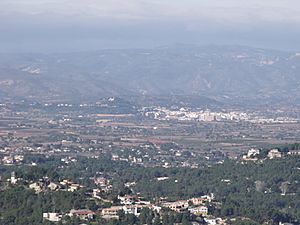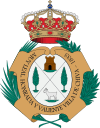Chiva, Spain facts for kids
Quick facts for kids
Chiva
|
|||
|---|---|---|---|
 |
|||
|
|||
| Country | |||
| Autonomous community | |||
| Province | Valencia | ||
| Comarca | Hoya de Buñol | ||
| Judicial district | Chiva | ||
| Area | |||
| • Total | 178.7 km2 (69.0 sq mi) | ||
| Elevation | 270 m (890 ft) | ||
| Population
(2018)
|
|||
| • Total | 14,941 | ||
| • Density | 83.609/km2 (216.55/sq mi) | ||
| Demonym(s) | Chivano/a | ||
| Time zone | UTC+1 (CET) | ||
| • Summer (DST) | UTC+2 (CEST) | ||
| Postal code |
46370
|
||
| Official language(s) | Spanish | ||
Chiva is a town in the Valencian Community in Spain. It is part of the Hoya de Buñol area. About 16,750 people live there (as of 2023). Most people in Chiva speak Spanish. The town is about 31 kilometers (19 miles) from the city of Valencia, heading towards Madrid.
Chiva is special because it has the largest municipal park in Valencia. This park is called the Sierra de Chiva Natural Park. It covers more than 5,500 hectares (about 13,600 acres). This area is protected because it is important for nature, beautiful views, and history.
Contents
Chiva's Long History
Chiva has a very old history. People have found signs of human life from the Metal Age, and also from the Iberians and Romans. The first people lived here between 8,000 and 5,000 BC.
From Muslim Rule to Christian Control
For many centuries, Chiva was under Muslim rule as part of Al-Andalus. Around 1246 or 1247, King James I of Aragon took control of Chiva. This was part of the Reconquista, an effort to bring the Iberian Peninsula back under Christianity. Even after the conquest, many Muslim people stayed in Chiva. The town's ownership changed hands many times over the years.
Changes and Growth in Chiva
In 1519, there was a big uprising called the Revolt of the Brotherhoods. During this time, some people wanted the Muslim population to become Christian. The Muslim people in Chiva did not agree. Later, in 1609, most of the Muslim people (called Moriscos) were forced to leave Spain. This made Chiva almost empty.
By 1797, Chiva started to grow again. This was mostly because of farming, both on dry land and with irrigation. In the mid-1800s, there was some industry related to farming. The arrival of the railway and more vineyards helped the economy grow even more.
Modern Chiva
In the 20th century, workers' rights movements became important in Chiva. There were big events like a strike in 1911. The town's population and industry grew a lot. However, the wine industry faced problems, which led to a time when the economy and population went down. This lasted until the 1970s.
After the 1970s, Chiva grew again. This was due to new industries and many people building second homes there. Being close to the big city of Valencia also helped Chiva's growth.
Important Places in Chiva
Chiva has several interesting historical sites and monuments:
- The old ruins of the Castle of Chiva.
- The Chiva Tower, also known as La Torreta.
- The Chiva Optical Telegraphy Tower. This tower was part of an old communication system from Madrid to Valencia. It even has gun ports!
- The Chapel of the Virgen del Castillo.
- The Archpriestly Church of San Juan Bautista, built in the 18th century.
- A collection of paintings by the famous Valencian Baroque painter José Vergara Gimeno.
- The Fountain of the 21 spouts, which has a special modern design.
Famous People from Chiva
Some well-known people were born in Chiva:
- Luis Antonio García Navarro: A famous music conductor (born 1941).
- José Morea: A talented artist (born 1951).
- Enrique Ponce: A renowned bullfighter (born 1971).
See also
 In Spanish: Chiva (España) para niños
In Spanish: Chiva (España) para niños




